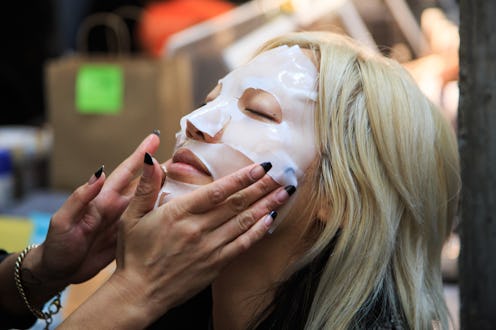Fashion
This Is How Often You Should Really Use Face Masks
Regardless of whether you lean towards sheet masks, clay masks, overnight masks, or maybe even a little bit of everything to help boost your complexion, if you're a fan of these more intensive, skin treatments, you may be wondering just how often you can safely use face masks anyway. After all, most directions say masks should only be used once or twice (max!) per week. But what if you have a bunch of different types that are all only meant to be used once per week? Could you actually use a different mask every day of the week without harming your skin? To find out just how liberal you can be with your treatments, I emailed with a few experts.
Jordana Mattioli, NYC-based esthetician; Nicolas Travis, founder of Allies of Skin; and Dr. Elizabeth Tanzi, founder and director of Capital Laser & Skin Care and Assistant Clinical Professor for the Department of Dermatology at the George Washington University Medical Center, all revealed which types of masks you can use throughout the week and which types are best used sparingly. The consensus among these experts is that, as long as your mask-of-choice is a hydrating one, you can use it every single day if you wish.
Allies of Skin 1A Overnight Mask, $89, Amazon
However, with just about every other type of mask that is not primarily for hydrating purposes, it's best to limit or alter your use. If you're unsure as to what types of benefits your face mask offers, Mattioli suggests checking the ingredients. Ingredients like antioxidants, hyaluronic acid, aloe, vitamins, and niacinamide, she says, are great to use every day. Products with heavy fragrance or exfoliating, anti-aging, or anti-acne properties could be too irritating to use more frequently than once or twice per week though, says Dr. Tanzi.
Even though clay masks tend to fall in the category of being too irritating to use more than once or twice per week, Travis has a way around that if you find clay masks really work for your skin. Especially if you prefer these types of masks to help tackle breakouts, here's how he recommends using them:
When using a clay mask daily, the trick is to not let it completely dry out. If it normally takes 15 to 20 minutes for your favorite clay mask to dry, leave it on troubled areas for five to 10 minutes and then rinse off. This allows the active ingredients to work without over-drying. Always follow up with something hydrating.
DERMAdoctor Kakadu C Amethyst Clay Detox Mask, $58, Amazon
If you have sensitive skin or just want a more moisturizing way to treat breakouts on the daily, another option Travis presents is a DIY, honey mask. He swears by manuka or raw honey mixed with turmeric, as this simple mask helps reduce inflammation and breakouts, and brightens and hydrates the skin. Just remember to apply this mask on already-damp skin, he says, so you can reap the most benefits from the honey and turmeric combo.
Wedderspoon 100% Raw Manuka Honey, $34, Amazon
But even though there's a way to use clay masks more frequently if you so choose, the use of exfoliating masks that contain AHAs or BHAs (such as glycolic or salicylic acid) should be limited to once or twice per week to avoid over-exfoliation and irritation, says Mattioli. On nights when you do use an exfoliating mask, don't be afraid to couple it with other masks as well to get the most out of each treatment, though. For the ultimate, at-home masking-session, Travis recommends starting with an AHA/BHA peel to loosen dead skin cells. Next, he says, apply a clay mask to draw out oil and impurities. Follow up with a hydrating sheet-mask on clean skin, and then finally slather on a moisturizing overnight-mask to seal everything in.
Juice Beauty Green Apple Peel Full Strength, $46, Amazon
So while you should usually just follow the directions listed on your face masks, if you're craving an extra treatment, remember to always check the ingredients so you know which types of masks can be used back-to-back during the week. Plus, because there are ways to use clay masks more often, and hydrating masks can actually be used daily, as long as you mix and match the right ones, every night can be a masking night.
Images: Courtesy of Brands
